
Pompeo Girolamo Batoni stands as one of the most celebrated and technically gifted Italian painters of the 18th century. Born in Lucca on January 25, 1708, and working primarily in Rome until his death on February 4, 1787, Batoni navigated the shifting artistic currents of his time with remarkable success. He became renowned throughout Europe, particularly for his elegant portraits, but also excelled in creating compelling allegorical, mythological, and religious compositions. His work skillfully blended elements of the late Baroque, the burgeoning Rococo, and the nascent Neoclassical style, earning him a place as a significant precursor to the latter movement. His studio in Rome became an essential stop for international travelers, solidifying his reputation far beyond the Italian peninsula.
Early Life and Artistic Formation in Rome
Pompeo Batoni's journey into the world of art began in Lucca, Tuscany, where he was born into the family of a goldsmith, Paolino Batoni. This early exposure to fine metalwork may have instilled in him a sensitivity to precision and detail that would later characterize his paintings. However, his true passion lay in painting, and recognizing his talent, he moved to Rome around the age of 19, in 1727, to pursue formal artistic training. The Eternal City, the undisputed center of the European art world at the time, provided an unparalleled environment for the young artist.
In Rome, Batoni immersed himself in study. He diligently copied antique sculptures, particularly those housed in the Vatican Museums and other collections, absorbing the principles of classical form, proportion, and idealized beauty. He also studied the works of Renaissance and Baroque masters, with Raphael being a particularly profound influence. Copying Raphael's frescoes in the Vatican Stanze was a crucial part of his education, refining his draughtsmanship and compositional skills. He is also known to have studied under artists like Agostino Masucci and Sebastiano Conca, absorbing the prevailing Roman academic traditions.
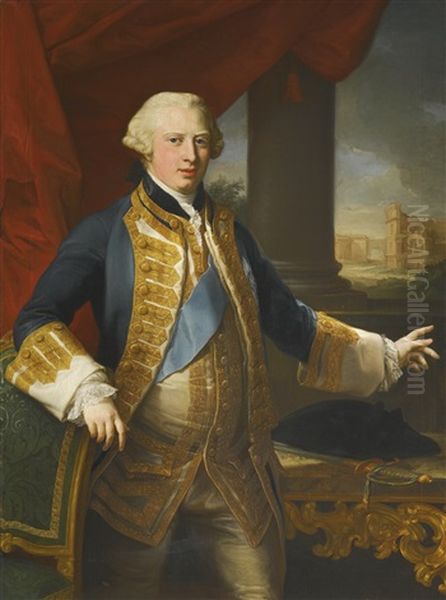
His early Roman years were marked by diligent practice and a gradual building of reputation. He initially gained recognition for his meticulous copies of classical statuary, which were admired for their accuracy and sensitivity. This foundation in classical antiquity, combined with an awareness of contemporary trends like the French Rococo and the enduring influence of Bolognese classicists like the Carracci and Guido Reni, shaped his developing style. Influences from earlier masters like Caravaggio, particularly in the handling of light and shadow, and the richness of painters like Peter Paul Rubens, can also be discerned in his mature work.
The Portraitist of the Grand Tour
While Batoni was adept in various genres, his fame reached its zenith through his extraordinary success as a portrait painter, particularly for the wave of international visitors undertaking the Grand Tour. Rome was the ultimate destination for these travelers, predominantly young British aristocrats, who sought cultural refinement through exposure to classical antiquity and Renaissance art. Commissioning a portrait in Rome became a fashionable way to commemorate this formative experience.
Batoni emerged as the pre-eminent portraitist for this elite clientele. His ability to capture not only a sitter's likeness but also their status, sophistication, and cultural aspirations made him exceptionally popular. He developed a distinctive format for these "Grand Tour portraits," often depicting his subjects full-length or three-quarter length, posed elegantly amidst evocative settings. These backdrops frequently included famous Roman landmarks, classical ruins like the Colosseum or the Temple of Vesta, antique sculptures such as the Apollo Belvedere or the Laocoön group, or idealized Italian landscapes.
These portraits were more than mere likenesses; they were carefully constructed statements of identity. The inclusion of classical artifacts signified the sitter's education and appreciation for antiquity. The elegant attire, confident poses, and Batoni's smooth, refined technique conveyed wealth and social standing. Works like the Portrait of Prince Edward Augustus, Duke of York or the Portrait of John Talbot, later 1st Earl Talbot exemplify this style, showcasing the blend of individual characterization with idealized classical references. His portrait of The 7th Earl of Northampton, housed in the Fitzwilliam Museum, Cambridge, is another prime example of his mastery in this genre.
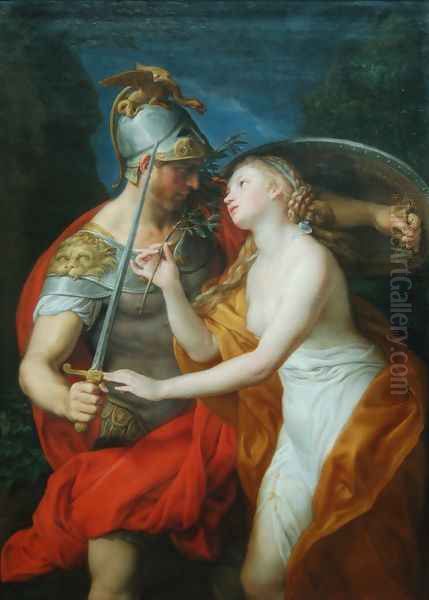
Batoni's success was such that he painted numerous members of British nobility and gentry, as well as visitors from other European nations, royalty, and high-ranking church officials. His studio became a social hub, and his portraits filled the collections of stately homes across Britain and the continent, serving as lasting mementos of the Grand Tour experience. He effectively created a visual language for the cosmopolitan elite of the 18th century. His skill in rendering luxurious fabrics, his clear and luminous palette, and the overall grace of his compositions set him apart from many contemporaries.
Mastery of Allegory, Myth, and Religion
Beyond the lucrative field of portraiture, Pompeo Batoni demonstrated considerable talent and ambition in history painting, encompassing allegorical, mythological, and religious subjects. These works allowed him to engage more directly with the classical and Renaissance traditions he so admired, showcasing his erudition and compositional skills on a grander scale. His training, which involved copying antique reliefs and Renaissance narratives, prepared him well for these complex multifigure compositions.
His allegorical paintings often explored abstract concepts through personification, rendered with clarity and elegance. Notable examples include the Allegory of the Arts and the Allegory of Peace and War. These works demonstrate his ability to translate complex ideas into visually compelling scenes, often characterized by balanced compositions, idealized figures, and a smooth, polished finish that appealed to the refined tastes of his patrons. Hercules at the Crossroads, housed in the Liechtenstein Museum, Vienna, tackles a classical moral theme with characteristic grace.
Mythological subjects provided Batoni with opportunities to depict dramatic narratives and idealized nude or semi-nude figures, drawing heavily on classical prototypes. Works like The Education of Achilles or Venus Hands the Arms to Aeneas (sometimes mistakenly identified as Agnes) reveal his engagement with epic literature and ancient mythology. These paintings often feature dynamic interactions between figures, set within carefully constructed landscapes or architectural settings, demonstrating his narrative skill. Apollo, Music and Geometry further highlights his interest in classical themes and harmonious composition.
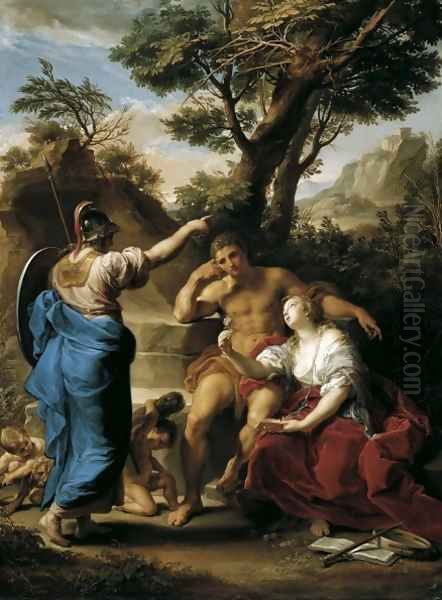
Batoni was also a significant painter of religious subjects, receiving commissions for altarpieces and devotional paintings for churches and private patrons, particularly within Rome and from the Church hierarchy. His religious works often blend Baroque emotional intensity with a more restrained, classicizing elegance. The Ecstasy of Saint Catherine of Siena and the Ecstasy of Saint Cecilia (considered a masterpiece of late Baroque sensibility) showcase his ability to convey spiritual fervor. Other works like The Holy Family, Madonna and Child in Glory, and depictions of the Madonna and Saint Anne demonstrate his capacity for tender and pious representation, often imbued with a gentle humanity. His relationship with the papacy is evidenced by portraits like that of Pope Benedict XIV Presenting the Encyclical Ex omnibus omnium and his later portrait of Pope Pius VI.
Artistic Style and Neoclassical Connections
Pompeo Batoni's artistic style is fascinating for its synthesis of diverse influences, reflecting the transitional nature of mid-18th-century European art. He masterfully combined the grace and lightness associated with the French Rococo, the solid compositional structures and idealized forms of Bolognese classicism (drawing from artists like Guido Reni), and a deep reverence for classical antiquity and High Renaissance masters like Raphael and the precise drawing associated with Nicolas Poussin. This unique blend resulted in a style characterized by elegance, technical polish, clarity, and a certain refined detachment.
His figures are typically idealized, with smooth skin, graceful poses, and serene expressions, even in dramatic scenes. His compositions are carefully balanced, often employing pyramidal structures or clear diagonal lines derived from classical principles. His color palette tends to be bright and luminous, with skillful transitions and a meticulous rendering of textures, particularly silks, velvets, and armor in his portraits. The influence of his father's goldsmith trade might be seen in this attention to fine detail and surface finish.
While Batoni incorporated elements appreciated by Rococo taste, such as elegance and charm, his underlying structure and preference for clarity align him more closely with the emerging Neoclassical movement. He is often considered a key precursor to Neoclassicism in Rome. However, he never fully embraced the severity and archaeological rigor advocated by the leading theorist of Neoclassicism, Johann Joachim Winckelmann, or practiced by his main rival in Rome, Anton Raphael Mengs.
The comparison with Mengs is instructive. Mengs, a German painter who also worked extensively in Rome and Madrid, was a more doctrinaire Neoclassicist, consciously striving for a style based on purified classical ideals and Raphael. Batoni, while deeply influenced by classicism, retained a greater degree of Rococo sensibility and a focus on painterly refinement that Mengs sometimes sacrificed for ideological purity. Their rivalry represented the dynamic tension between established tastes and the new, more austere aesthetic that would come to dominate the later 18th century. Batoni's work, therefore, occupies a crucial position, bridging the gap between the late Baroque/Rococo and full-fledged Neoclassicism.
Contemporaries and the Roman Art Scene
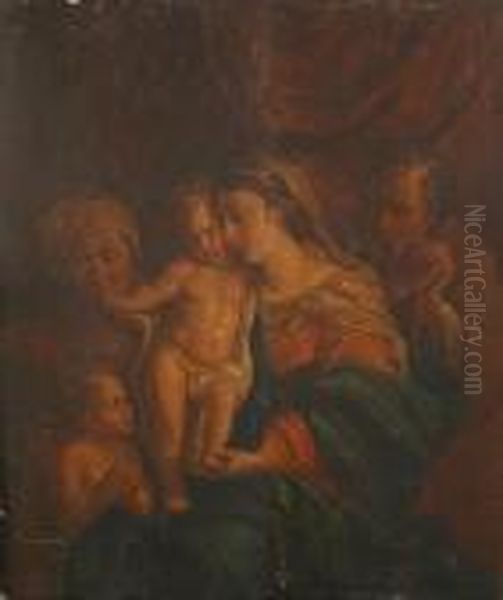
Pompeo Batoni operated within a vibrant and competitive artistic environment in 18th-century Rome. His career unfolded alongside numerous other significant Italian and international artists who were drawn to the city. His primary rival, as mentioned, was Anton Raphael Mengs, whose Neoclassical theories and prestigious commissions (especially from the Spanish court) presented a significant challenge. Their stylistic differences and competition for patronage defined much of the Roman art scene in the mid-century.
Batoni was also active in the city's artistic institutions. He held positions of leadership, collaborating with figures like Francesco Caccianiga at the Accademia Capitolina del Disegno and Giulio Carlo Carissimi at the prestigious Accademia di San Luca. These roles indicate his respected standing within the official art establishment of Rome. His studio was not only a place of production but also a social center, attracting artists, patrons, and intellectuals.
His network extended internationally, primarily through his Grand Tour clientele. He maintained connections with British artists and connoisseurs, such as his documented friendship with the visiting artist Julius Sanderson. The praise he reportedly received from figures associated with the legacy of Gian Lorenzo Bernini, such as Giuseppe Bernini, further attests to his recognition among Italian peers, linking him, at least in reputation, to the great traditions of Roman Baroque art.
While Batoni focused on portraiture and history painting, Rome and Italy were also home to other flourishing genres. View painters like Canaletto and Francesco Guardi were achieving fame in Venice depicting cityscapes, while Giovanni Battista Tiepolo, an early influence on Batoni, dominated large-scale decorative fresco painting. In France, artists like Jean-Honoré Fragonard explored Rococo themes, while Hubert Robert specialized in picturesque views of Roman ruins, a subject Batoni often incorporated into his portrait backgrounds. In Britain, portraitists like Sir Joshua Reynolds and Thomas Gainsborough were Batoni's contemporaries, sometimes painting the very same aristocrats who sat for Batoni during their travels in Italy. Batoni's success lay in offering a distinctly Roman, classically-inflected style of portraiture that complemented, rather than directly competed with, the styles prevalent elsewhere.
Legacy and Historical Reputation
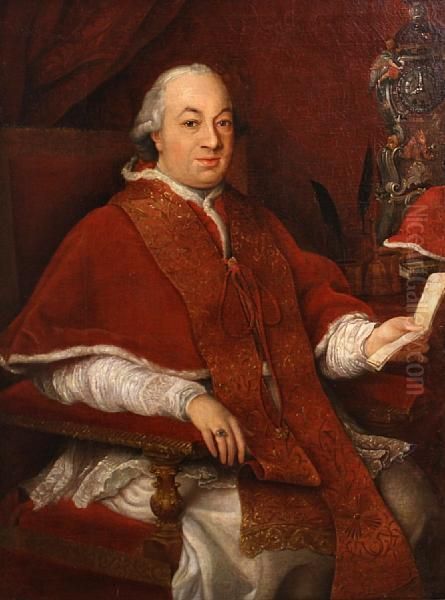
During his lifetime, Pompeo Batoni enjoyed immense fame and financial success. He was widely regarded as the leading painter in Rome after the departure of Mengs and was sought after by popes, emperors (like Joseph II), and aristocrats from across Europe. His portraits, in particular, became status symbols, defining the image of the cosmopolitan Grand Tourist for generations. His influence extended to patrons' tastes back home, particularly in Britain, where his elegant classicism resonated with Enlightenment ideals and the aesthetics promoted by figures involved in landscape design like Lancelot "Capability" Brown (though Brown was an architect, the taste for idealized landscape was shared).
However, following his death in 1787, Batoni's reputation began to decline. The rise of a more austere and archaeologically precise Neoclassicism, followed by Romanticism and subsequent 19th-century movements, led critics to view his style as somewhat superficial or overly polished. He was sometimes dismissed as "the last of the Old Masters," implying his work represented the end of a tradition rather than the beginning of something new. His immense popularity with the British aristocracy also led some later critics to view him primarily as a society painter, overlooking the seriousness and skill evident in his historical and religious works.
The 20th and 21st centuries have witnessed a significant reassessment and revival of interest in Batoni's work. Art historians now recognize the complexity of his style and his crucial role in the transition from Rococo to Neoclassicism. Major exhibitions and scholarly publications have shed new light on his oeuvre, highlighting his technical brilliance, his intelligent synthesis of artistic traditions, and his importance as a chronicler of 18th-century European elite culture.
Today, Batoni is acknowledged not merely as a fashionable portraitist but as a major figure in 18th-century European art. His works are prized for their elegance, psychological insight (particularly in portraits), and masterful technique. He is understood as an artist who successfully navigated the complex artistic and cultural landscape of his time, creating a body of work that is both representative of its era and possesses enduring aesthetic appeal. His position as a foundational figure for certain aspects of Neoclassical painting is now widely accepted.
Collections and Where to See His Work
Pompeo Batoni's prolific output ensures that his works can be found in numerous major museums, galleries, and private collections across Europe and North America. Italy, naturally, holds significant works. While specific locations for works like Madonna and Child in Glory are sometimes listed as 'public domain,' key pieces reside in Roman institutions, including churches and potentially the Vatican Museums, reflecting his close ties to the city and the papacy. The work Pope Benedict XIV Presenting the Encyclical Ex omnibus omnium is documented in collections accessible via platforms like Artvee.
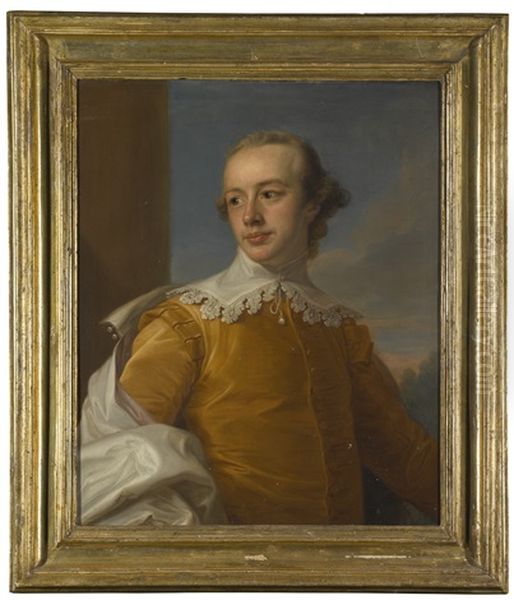
The United Kingdom holds a particularly rich collection of Batoni's works, largely due to his popularity with British Grand Tourists. Many portraits remain in the private collections of descendants of the original sitters or in stately homes managed by organizations like the National Trust. Public collections in London hold important examples, such as the Portrait of Prince Edward Augustus, Duke of York. The Fitzwilliam Museum in Cambridge houses the notable Portrait of the 7th Earl of Northampton.
Elsewhere in Europe, significant works can be found. Spain's Museo de la Real Academia de Bellas Artes de San Fernando in Madrid holds the Portrait of Don Manuel de Roda. Austria's Liechtenstein Museum in Vienna possesses the mythological painting Hercules at the Crossroads. In Switzerland, the auction house Dorotheum in Zurich has handled works like Apollo, Music and Geometry, indicating the circulation of his paintings on the international art market. His works were historically known to be in collections in Berlin and St. Petersburg as well.
In recent decades, museums in the United States have increasingly acquired works by Batoni, recognizing his importance in the history of European art. While specific examples were not detailed in the initial source material, major American museums with strong collections of European painting are likely to hold or exhibit his works. Furthermore, numerous paintings remain in private collections, occasionally appearing at auction or on loan to exhibitions, continuing to surface and add to our understanding of this prolific master.
Conclusion
Pompeo Girolamo Batoni was far more than just a fashionable painter of his time. He was a consummate artist whose career successfully bridged the late Baroque, Rococo, and Neoclassical periods. Born in Lucca and flourishing in Rome, he absorbed the lessons of classical antiquity and the great masters like Raphael, combining them with contemporary elegance to create a distinctive and highly sought-after style. His portraits of Grand Tourists provide an invaluable visual record of 18th-century elite society, while his allegorical, mythological, and religious paintings demonstrate his ambition and skill in the more traditional hierarchies of artistic genres.
Though his fame waned in the century following his death, modern scholarship has rightfully restored Batoni to a prominent place in art history. He is recognized for his technical virtuosity, his sophisticated compositions, his sensitive rendering of character, and his crucial role as a precursor to Neoclassicism. As both a master craftsman and an astute interpreter of his era's cultural aspirations, Pompeo Batoni remains a compelling and important figure, whose elegant canvases continue to captivate viewers in museums and collections around the world.